Jeanette Larson's Blog
March 15, 2023
Black-necked Stilts
November 13, 2022
How to Find a Bird
 Jennifer Ward's How to Find a Bird offers a wonderful look at, well, how to find birds. Blend in, be quiet, look low to the ground, and be as sharp as an eagle's eye and you will find birds. Wait and be patient is often the best advice. And sometimes birds find you.
Jennifer Ward's How to Find a Bird offers a wonderful look at, well, how to find birds. Blend in, be quiet, look low to the ground, and be as sharp as an eagle's eye and you will find birds. Wait and be patient is often the best advice. And sometimes birds find you. Lushly illustrated by Diana Sudyka, the picture book is full of details and lots of birds, each labeled. One double-page spread even includes extinct birds like the Dodo and the Ivory-billed woodpecker. The final two pages offer advice on how to be a bird watcher. Great to read aloud to a young child or give as a gift.
October 16, 2022
Bird of the Week: Whooping Cranes As a Master Birder ...
Bird of the Week: Whooping Cranes
 As a Master Birder I have to volunteer with Travis Audubon Society. One of the things I'm doing is contributing to their "Bird of the Week" site. Read about Whooping Cranes. They are starting to arrive in Texas. https://travisaudubon.org/uncategorized/bird-of-the-week-whooping-cranes . And while you are there, look at the information about other birds in Texas.
As a Master Birder I have to volunteer with Travis Audubon Society. One of the things I'm doing is contributing to their "Bird of the Week" site. Read about Whooping Cranes. They are starting to arrive in Texas. https://travisaudubon.org/uncategorized/bird-of-the-week-whooping-cranes . And while you are there, look at the information about other birds in Texas.
I'll post information here after the posts publish for Audubon.
June 25, 2022
All About Birds: Texas and Oklahoma opens with a fold-out...

All About Birds: Texas and Oklahoma opens with a fold-out index of birds by categories but the table of contents includes a break down by species within each category. Early chapters focus on beginning birding, attracting birds to your yard, and getting involved with birding. Especially appreciated is the section on types of food and feeders. A guide to common species found in Texas and Oklahoma follows. Information is drawn from Cornell’s AllAboutBirds.com. As noted in the welcome, each profile includes a map of the usual territory and full-color photos to help with plumage variations. The profile section starts with general tips for identifying birds by various traits and understanding field marks. An end of the book index helps locate specific information. Most birders probably wouldn’t carry this big of a book into the field, but it is great for learning about birds you are looking for at home or in the “wild.” Definitely worth adding to your bird collection. Other titles in the series cover California and four regions of the country.
June 11, 2022
Shorebird ID Guide
Cornell Lab has some great resources. I wanted to share this Shorebirds Identification Chart. Two pages!
"From plovers to peeps and beyond, become familiar with the diversity of shorebirds with this free downloadable guide! Paying attention to shape, size, and behavior goes a long way to identifying shorebirds. This helpful shorebird ID guide has full-color photos, ID tips, and a size reference chart for use at home or out in the field. You can download, print out, and bring this guide with you!"
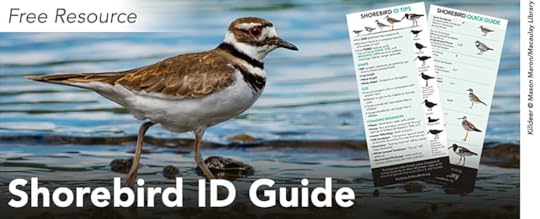
Shorebirds Identification Chart
August 20, 2021
Sharing Information
It's been almost exactly a year since my last blog post. Blame it on lock-down laziness? I wasn't doing much birding during the time of Covid and I also was in the hospital and recovering from open heart surgery (I'm fine now.) BUT, I was taking a number of online classes about birds (and cooking, but not cooking birds--I'm vegetarian).
"Once you discover something it's important to share that information." This advice comes from the scientists at the World Center for Birds of Prey in Boise, ID. I discovered the Center while taking a kid's course through Varsity Tutors. Most of their classes are free or available for a very low cost. And while they say that this class was for children, it was very enlightening for adults also, so take a class with a kid or by yourself. Varsity Tutors also offers classes on dinosaurs, ancestors of today's birds, and many other topics.
During the one hour class, Saving Raptors, Curtis Evans shared information and introduced us to some of the birds of prey that are currently living at the Center. In addition to rehabilitation, the Center raises endangered birds to be released back into the wild. Many birds at the Center are used in educational situations if they can't be released. The Center also works around the world to help prevent habitat loss and extinction.
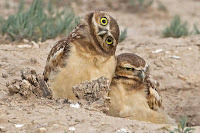 Burrowing owls (Photo by
Burrowing owls (Photo byThe Peregrine Fund)
One thing I've learned as a birder is that we are always learning new things about birds! Owls borrow a nest someone else, like a hawk or eagle, has made. Or smaller owls go into cavities in trees or barns. Vultures lay eggs on a scrape on a cliff or in a cavity. Hawks and eagles make nests. Falcons may nest on the edge of buildings. (See Tower Girl at the University of Texas at Austin) Eagles build very large nests adding to the building every year. Nests are not deep but the birds continue adding a clean layer to the nest.
 Milky eagle owl
Milky eagle owl(Photo by the Peregrine Fund)
One of the most amazing raptors shown was the Milky Eagle Owl, Africa’s largest owl, commonly known as the Giant Eagle Owl, its correct name is the Verreaux's eagle-owl. The one at the World Center is an owl that hatched at the Atlanta Zoo, where one can be seen also. Hand raised, the owlet then went to Idaho where it remains. So now I have to plan a visit!
Hopefully I can get back on track now that there is some return to normalcy. Wearing a mask, I am going to lectures, getting out to bird, and travelling some. And, of course, always learning.
August 17, 2020
The Thing With Feathers: The Surprising Lives of Birds and What They Reveal About Being Human

Noah Strycker is often described as a “birder at large” and he has birded around the world. In 2015 he completed a worldwide big year, seeing almost 60% (6,042) of the world’s 10,400 bird species on all seven continents. That, along with his degree in Fisheries and Wildlife Sciences and many field trips, allows him to explore the behaviors of different bird species and how their behaviors connect with that of humans in The Thing With Feathers.
Each chapter focuses on a single species, and it should be noted, those included are often not the “rock stars of ornithology.” The chapters are divided into three sections: Body, Mind, Spirit. Strycker focuses on experiments and studies that support his ideas that “[b]ird behavior offers a mirror in which we can reflect on human behavior.”
He explores how pigeons learn to find their way home and the navigational skills of other species and why bower birds decorate their nests and appreciate their own version of art. Magpies are able to recognize themselves in mirrors and nutcrackers have amazing memories and can recall literally hundreds of locations where they have stored seeds. Especially interesting is the examination of pecking order in chickens. Vultures can distinguish taste, preferring to eat the carcasses of herbivores rather than carnivores. Without anthropomorphizing, Stryker explains these behaviors and frequently connects it to our world and helps us learn what it means to be human.
Each chapter includes a drawing of the bird being discussed. End Notes explain the sources for his research and describes themes that are based on Strycker’s own interpretations from his field experiences. Each note offers additional readings and films for those who want to further explore the described behaviors.
The book’s title comes from an Emily Dickinson poem (“Hope” is the thing with feathers) and Strycker’s writing is equally poetic and passionate. The chapters are easy to dip into and encourages readers to reflect on our own behaviors. Note that Dickinson’s poem has served as inspiration for several books with the same, or almost the same, title so be sure to check the author.
 Black vulture (photo
Black vulture (photoby Jeanette Larson)
August 10, 2020
7 Pleasures of Birding
Caldecott Award-winning illustrator, Matthew Cordell (Wolf in the Snow) was inspired by a series of comment mades in a documentary called "Birders: The Central Park Effect" to draw the 7 pleasures of birding. He graciously gave me permission to share his art here. I'm posting without additional comment as Cordell and Chris Cooper, who came up with the list, express the joys of birding better than I possibly could.
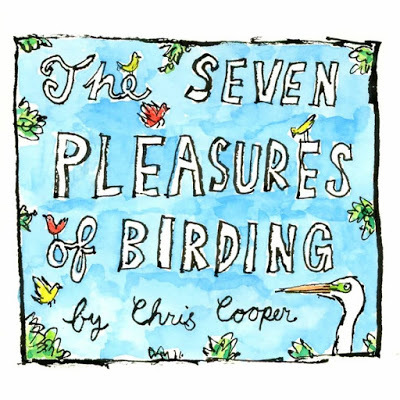

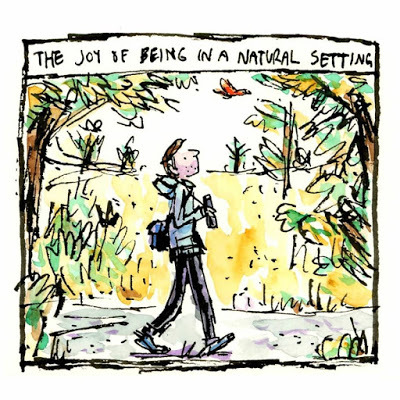
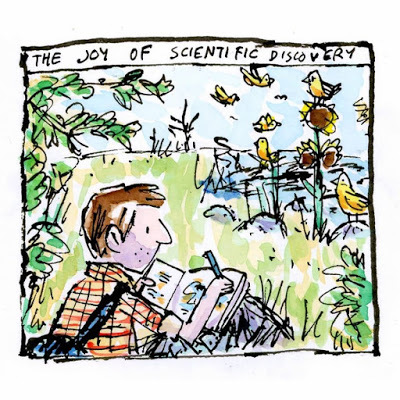
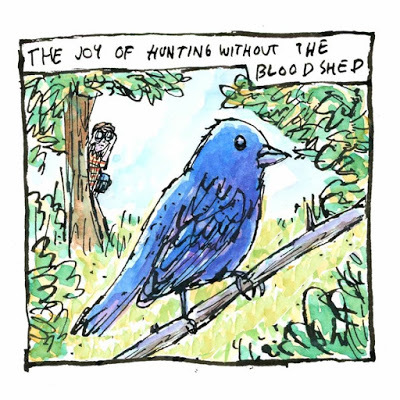


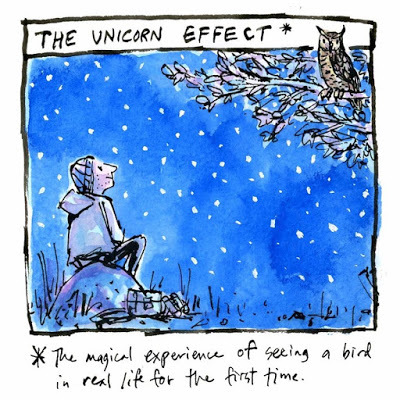
All illustrations are copyright Matthew Cordell and are used with permission.
May 26, 2020
Numenia and the Hurricane
 Numenia and the Hurricane: Inspired by a True Migration Story
Numenia and the Hurricane: Inspired by a True Migration StoryI’ll start by saying this is a book I would have loved to have written. We were living in Rockport, TX during Hurricane Harvey. While my family and pets evacuated, many birds could not, and I learned how hard it was for birds to survive a storm. When we returned to the devastated area, it was heartbreaking to see the avian carnage. Pelicans had been slammed against the jetties and seawalls, where their carcasses decayed. Many of the migratory birds left but native birds didn't know to go and died. Thankfully, hummingbirds had not started their fall migration and were fine, although people had to step in to feed them as most plants were defoliated. For three months we didn’t see even a grackle or a dove. But slowly, the birds returned. Numenia and the Hurricane is a somewhat different hurricane story and one with a happier ending.
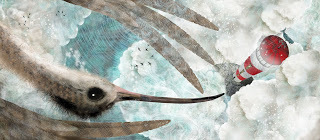 During a hurricane, strong winds blow birds off their path, often leading them to new places or wearing them out so that they don't have to stamina to follow their original path.
During a hurricane, strong winds blow birds off their path, often leading them to new places or wearing them out so that they don't have to stamina to follow their original path. Inspired by the true story of Hope, a whimbrel being tracked by scientists, Halliday tells the harrowing tale of a lone whimbrel, separated from her sisters during their southward migration from the Arctic. Lyrical lines of text help us to feel for the poor bird as she is tossed and turned, battered by the strong winds. Readers learn that Numenia preservers for 27 hours, alone, until finally, somehow, with good natural instincts but plenty of wrong turns, she makes it to the US Virgin Islands, tired and hungry, but safe with her sisters.
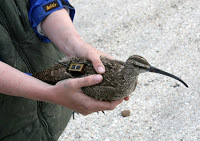 Hope with her tracking device.
Hope with her tracking device. Photo Credit: Barry Truitt.
As explained in the end notes, Numeria’s story is based on a bird named Hope, caught in Tropical Storm Gert and blown way off course in 2011. Hope was tracked by researchers for several years, allowing them to marvel at the whimbrel’s stamina and fortitude during many courageous migration journeys. Like Numeria’s story, her journey was amazing but one that many birds face each year during their journey between winter and summer habitats. The Whimbrel’s range is rather limited, but they travel each year between Canada and the Eastern and Southern US coasts, as well as into the Caribbean.
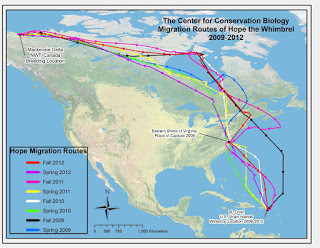
Halliday’s art is visually stunning and allows the reader to feel like they are inside the hurrican bouncing along with Numenia. Interesting perspective and angles give us a birds-eye view of the danger and confusion this small bird faces. With great illustrations and text, this is a great choice for read-aloud. Halliday is an accomplished birder and naturalist and I hope this is the first of many bird books we’ll see from her.
Click on the tab for BOOKS ABOUT BIRDS for a list of all books mentioned in the blog posts.
FTC Notice: The author provided me with an electronic copy of the book to review.
May 20, 2020
Birdwatching in the Time of Corona
Bird Watcher's Digest offers several Bird Bingo! cards for different regions of the county. Spring migration is still underway so most of us should have no problem getting a straight-line BINGO! Who's up for the challenge? (Download your region if you are not in Texas.)





